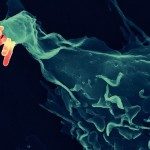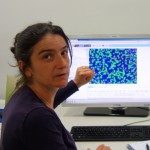Link to Pubmed [PMID] – 25299335
Cell Host Microbe 2014 Oct;16(4):517-30
Shigella enters epithlial cells via internalization into a vacuole. Subsequent vacuolar membrane rupture allows bacterial escape into the cytosol for replication and cell-to-cell spread. Bacterial effectors such as IpgD, a PI(4,5)P2 phosphatase that generates PI(5)P and alters host actin, facilitate this internalization. Here, we identify host proteins involved in Shigella uptake and vacuolar membrane rupture by high-content siRNA screening and subsequently focus on Rab11, a constituent of the recycling compartment. Rab11-positive vesicles are recruited to the invasion site before vacuolar rupture, and Rab11 knockdown dramatically decreases vacuolar membrane rupture. Additionally, Rab11 recruitment is absent and vacuolar rupture is delayed in the ipgD mutant that does not dephosphorylate PI(4,5)P₂ into PI(5)P. Ultrastructural analyses of Rab11-positive vesicles further reveal that ipgD mutant-containing vacuoles become confined in actin structures that likely contribute to delayed vacular rupture. These findings provide insight into the underlying molecular mechanism of vacuole progression and rupture during Shigella invasion.





